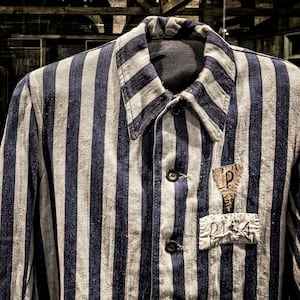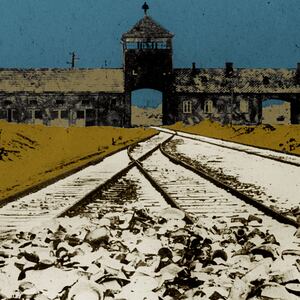I first encountered Rudolph Vrba, distinguished professor of biochemistry at the University of Vancouver, survivor of Auschwitz, back in the late 1980s, when I had the privilege of watching Shoah, Claude Lanzmann’s epic film masterpiece about the Holocaust. The purpose of the film, says Yale historian Timothy Snyder, is “to bring the viewer into contact with the seemingly impossible, the unqualified nothingness of mass death.”
Lanzmann succeeds. Shoah is an exceptionally moving and morally disturbing piece of work.
Astonishingly, this nine-hour masterpiece contains no archival footage. It is composed entirely of clips from Lanzmann’s interviews with an eclectic array of survivors, perpetrators, and bystanders. Many of the interviews are conducted on the eerily peaceful, deserted grounds of the death camps, or the towns nearby.
ADVERTISEMENT
Vrba, a Slovakian Jew born in 1924, cuts quite a figure. Still handsome and vital in his early sixties at the time the film was made, he recounts his vast experience of the horrors of the camp in crisp, confident English, with a striking amalgam of irony, intelligence, and… yes, if you can believe it, wry humor.
“Rudi” survived some 22 months in Auschwitz—no mean feat in and of itself. By the ripe old age of 19, he had narrowly escaped death at least a dozen times, all while acquiring a huge cache of information and wisdom about the process of industrialized death. He escaped the camp—one of only five Jews to do so—and made a Herculean effort to expose the horrors of the death camps to the world.
For a good 10 months, his job was to unload the train box cars of corpses and the worldly possessions of European Jews en route to the gas chambers. As he tells Lanzmann:
<p><em>There was always an amount of people who could not get out of the railroad cars, those who died on the road, or people who were sick to such a degree that even persuasion with violent beating wouldn’t get them moving fast enough. So these people remained in the wagons. So our first job was to get into the wagons, get out the dead bodies—or the dying—and transport them </em>in laufschritt<em>, as the Germans liked to say. This means “running.” </em>Laufschritt<em>, yeah, never walking—everything had to be done </em>in laufschritt, immer laufen<em> [Running, always running]. So very sporty—it is a sporty nation, you see.</em></p>
The irrepressible Vrba never received the public acclaim he so richly deserved. With the publication of British journalist Jonathan Freedland’s The Escape Artist: the Man Who Broke Out of Auschwitz to Warn the World, this is bound to change, for this is a riveting account of a truly exceptional human being. The Escape Artist is a classic page-turner, half adventure, half horror story—a gut-wrenching tribute to the power of the human spirit to endure unimaginable suffering, to rise above death, and ultimately, to prevail over it.
During his 22 months in the camp, Rudi held quite a number of jobs. He worked 16-hour days in a gravel pit; he was a slave laborer at a synthetic rubber factory, where he shifted heavy bags of cement all his waking hours. “He had to run as fast as he could [with each bag], dodging his way through an assault course of Kapos prodding him to move ever more quickly, whipping or hitting him every 10 to 15 yards,” writes Freedland. “Rudi saw fellow prisoners fall, only for a Kapo to crush their skull, leaving a corpse Rudi had to take care not to trip over. Once he had reached the mixing machine… he had to run back, double time, to get another bag… For hours it went on, in the heat and the dust, without food or drink or pause.”
It was during his 10 months “on the ramp,” unloading bodies and possessions, that Rudi came to an epiphany. As he put it after the war, “The whole murder machinery would work on only one principle: that the people came to Auschwitz and didn’t know where they were going and for what purpose. The new arrivals were supposed to be kept orderly and without panic marching into the gas chambers… The Nazis were concentrating on one thing: it should go in an orderly fashion so that it goes unimpeded. One doesn’t lose time.”
Vrba’s pluck and likeability ultimately landed him in the coveted position of a mortuary registrar, where he was able to wear his own clothes, had quite a bit of independence, and had access to all sorts of records about the trains, the gassings, and the victims’ identities.
In early 1944, he learned that the SS was planning on bringing more than 1 million Hungarian Jews to the camp for extermination. He decided he had to escape, with a view to averting this impending disaster. “It was no longer a question of reporting a crime,” he would later say, “but of preventing one.”
With considerable help from a bear of a Russian POW—a captain who had escaped Sobibor, he developed an ingenious escape plan. On the evening of April 10, 1944, Vrba and another Slovakian Jew named Alfred Wexler slipped outside the camp’s outer perimeter and made a harrowing, 80-mile journey back to Slovakia. At several junctures, they were on the verge of being captured or killed, but they made it, ultimately finding their way to the Jewish Council in their native country. Freedland’s account of the escape will keep you on the edge of your seat.
In Slovakia, under the Resistance’s protection, the two escapees prepared a remarkably accurate, detailed report describing what the “Final Solution” had wrought in Auschwitz. Much to Vrba’s dismay, the Hungarian government, then in negotiations with the Nazis about the mechanics of the “resettlement” of the Jews, shelved the report, and 437,000 Hungarians were gassed in Auschwitz between May and July 1944.
But the Vrba-Wexler Report was soon published in Switzerland, and made its way to British and American officials, who were successful in pressuring the Hungarian government to cease deportations, thereby infuriating senior Nazi officials, including Heinrich Himmler, head of the SS.
It's clear that in the end, Rudi Vrba’s determination to spread the word about the horrors of the camps ended up saving the lives of at least 10,000 Hungarian Jews, and probably more.
The report also made its way all the way up to Roosevelt and Churchill. As we know, they declined Rudi’s urgent plea to bomb the rail lines leading to the camp on the grounds that the best way to limit the killings in the gas chambers was to press on and defeat the Germans as fast as possible using the strategy already agreed with the Russians.
After the war, Vrba provided invaluable testimony at numerous war crimes trials, and in a series of documentaries, but he refused, as Freedland puts it, “to conform to what the world expects of a Holocaust survivor… his voice is loud and confident… he employs sardonic, sarcastic humor. And he smiles, as if amused by the lunatic absurdity of what he is describing, even when speaking about the unspeakable.”
This is a powerful and inspiring story of an authentic hero who shone a bright light on one of the darkest chapters in all of human history. Do yourself a favor and read it. Maybe not before the holidays, but soon.








